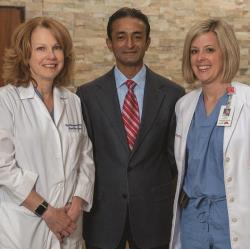
When car brakes wear down over time, they eventually have to get replaced. The same kind of thing can happen inside of the body as we age, especially in the heart. The heart works tirelessly, pumping and circulating blood around the body every minute of every day. On top of this, factors like calcium build up and rheumatic fever can contribute to making the valves more stiff, fragile, and weak over time. This wear and tear of the heart’s valves can potentially cause aortic valve stenosis.
Aortic valve stenosis is a condition where the heart’s aortic valve begins to shrink. This limits the blood flow from the heart to the rest of the body, leading to symptoms like shortness of breath and dizziness. One would think that heart surgery is the automatic solution, but for some patients, it is too risky. A patient may be too old or frail to be put under for surgery and recover later on.
“Unfortunately, untreated aortic valve disease is fatal. After symptoms begin, the survival rate is as low as 50% at 2 years,” says Grace Lavalley, a cardiology nurse practitioner. “The definitive treatment for aortic valve stenosis has been aortic valve replacement (AVR) surgery.”
With AVR surgery, the patient is put under anesthesia and the chest is cut open. The heart is stopped and an artificial unit is used to pump the blood. The faulty valve is surgically removed and replaced with a new one. A patient may be in the intensive care unit for days after this surgery, and the chest could take up to two months to heal completely.
Easing the strain with TAVR
This intensive surgery now has a simpler solution with TAVR (Transcatheter Aortic Valve Replacement), a minimally-invasive valve procedure. A patient has to be referred by their primary care provider or cardiologist to receive TAVR.
“If AVR surgery is not an option, TAVR is a fantastic alternative for those who may be considered intermediate to high risk for surgery,” adds Lavalley. TAVR was first implemented in in-operable or high-risk patients for surgery. The procedure has since expanded to intermediate risk patients. Baystate will see further expansion of the procedure to lower-risk patients based on current low-risk trials done in the United States. Dr. Ashequl Islam was a part of the cardiac team that brought TAVR to Baystate several years ago, and has since studied its effectiveness.
“We are excited to offer TAVR to the very large patient population which we serve,” he says. Results of nationwide clinical trials for TAVR have shown better or equivalent results compared to open heart surgery. With TAVR, patients do not undergo open heart surgery, are given minimal sedation, and their length of stay is significantly reduced with no need for intensive care. Patients are more alert and awake and can be back on their feet within hours.
How TAVR is performed
For most TAVR patients, surgeons make a small cut in the groin area and insert a tube with the new valve up into the diseased valve, removing the need for external pumps to keep the heart and lungs working. The new valve is implanted and anchored in the existing valve, giving it new life. After the catheter tube is pulled out, the entry site is stitched up.
The future of TAVR at Baystate
“TAVR is one of those revolutionary procedures that has really changed the world of cardiac care,” adds Dr. Islam. “A lot of patients couldn’t get treatment before this. Baystate is the only advanced heart and vascular hospital in western Massachusetts and this allows us to deliver state-of-the art, high quality care.
Cardiac patients would have to go out of the Baystate network if not for this type of procedure.” The cardiology team has expanded from TAVR to other valve procedures and treatments. They are also involved in clinical trials to investigate non-surgical treatment methods for other heart valve conditions.
“We are always looking at new and innovative ways to deliver the best heart care to our patients,” concludes Dr. Islam.